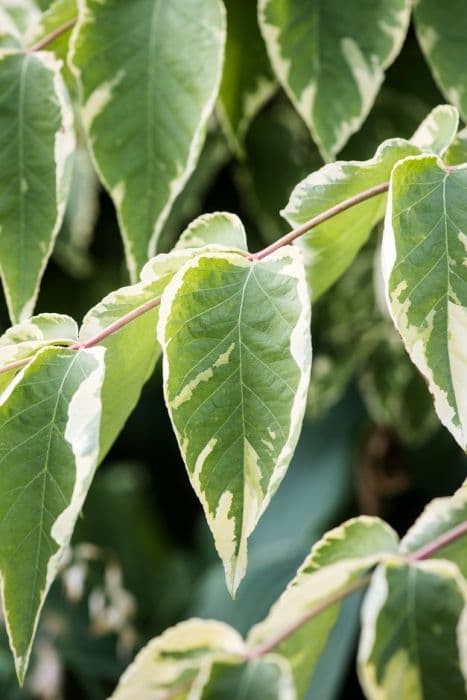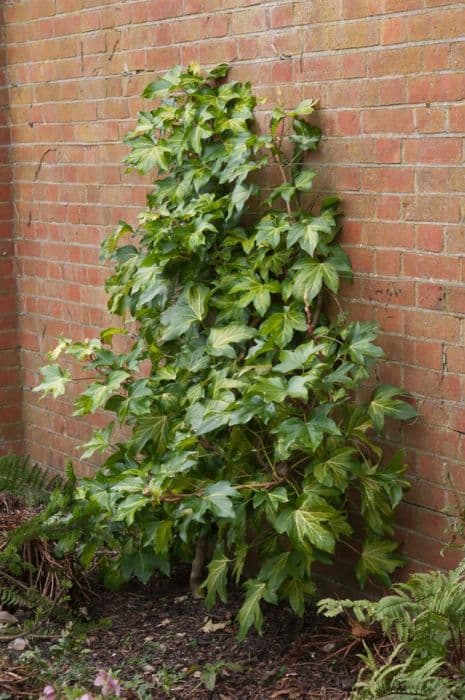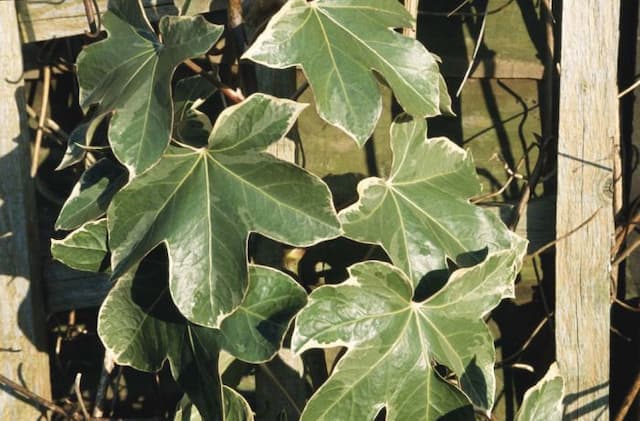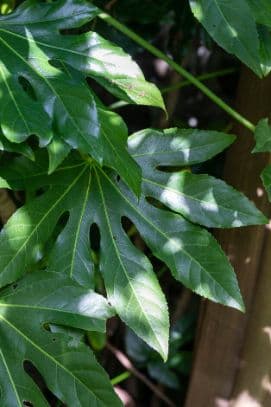Taiwanese Schefflera Schefflera taiwaniana
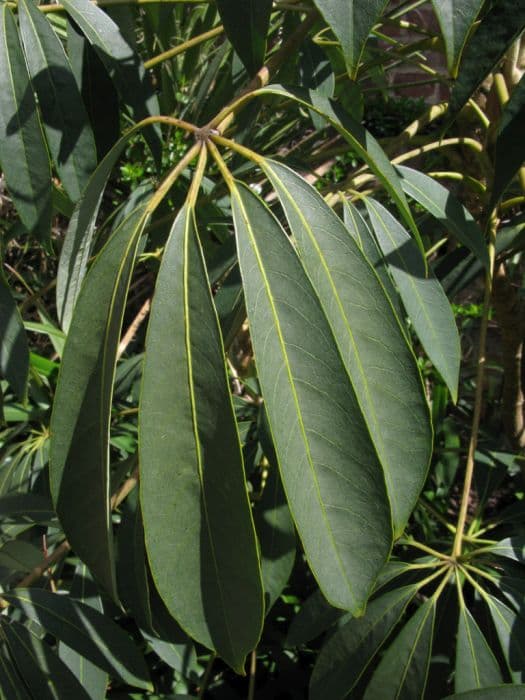
ABOUT
Schefflera taiwaniana, commonly known as the Taiwan schefflera, is a visually striking plant due to its foliage and overall structure. It typically displays a graceful, open form with multiple stems that branch out creating a somewhat airy appearance. The leaves of the Taiwan schefflera are one of its most distinctive features. They are compound leaves, which means each leaf stalk holds a collection of smaller leaflets. These leaflets are usually arranged in a circular pattern, giving them a hand-like or umbrella-like shape, which is a characteristic trait of the schefflera genus. In terms of color, the leaves exhibit a rich, deep green hue that can bring a lush, vibrant quality to any setting. The surface of the leaves has a glossy finish, which contributes to their attractive look, catching light and adding a bit of shine to the plant's profile. The plant may also bear inflorescences, which are groups of small flowers, but the foliage is generally the main visual appeal. The stems are typically sturdy, supporting the weight of the leaves but can have a slight arch due to their length and the distribution of the foliage. As the Taiwan schefflera matures, its stems can develop a more woody texture, offering a contrast to the soft and lustrous leaves. In terms of growth habit, the Taiwan schefflera generally spreads its branches outward and can create a considerable presence. It is well-suited as a focal point in a garden or indoor space due to its impressive leaf structures and overall form. The plant has an elegant demeanor and can be used effectively for ornamental purposes. It is important for potential growers to be aware of their local climate and indoor environment to make sure it's suitable for the Taiwan schefflera to thrive, but details about care requirements are beyond the description of its appearance.
About this plant
 Names
NamesFamily
Araliaceae
Synonyms
Taiwaniana Umbrella Tree, Taiwan Schefflera, Taiwanese Schefflera
Common names
Heptapleurum taiwanianum, Schefflera heptaphylla var. taiwaniana, Brassaia taiwaniana.
 Toxicity
ToxicityTo humans
The plant commonly known as the Schefflera is considered to be toxic to humans if ingested. The plant contains calcium oxalate crystals which can cause irritation to mucous membranes. If parts of the plant are chewed or swallowed, it can result in symptoms such as burning and swelling of the lips, mouth, tongue, and throat. It may also cause difficulty swallowing, nausea, vomiting, and diarrhea. Ingesting large amounts can lead to more severe problems, including difficulty breathing and intense burning and irritation. Contact with the sap can also cause skin irritation or a rash in sensitive individuals.
To pets
Schefflera is toxic to pets, including cats and dogs. If a pet chews or ingests parts of this plant, it can cause symptoms similar to those in humans due to the calcium oxalate crystals. These symptoms may include oral irritation, pain and swelling of the mouth, tongue and lips, excessive drooling, vomiting, difficulty swallowing, and in severe cases, it can cause breathing problems. If you suspect your pet has ingested Schefflera, it is important to contact your veterinarian promptly.
 Characteristics
CharacteristicsLife cycle
Perennials
Foliage type
Evergreen
Color of leaves
Varies
Height
10 feet (3 meters)
Spread
6 feet (1.8 meters)
Plant type
Tree
Hardiness zones
9
Native area
Taiwan
Benefits
 General Benefits
General Benefits- Ornamental Appeal: Taiwanese Schefflera is appreciated for its attractive foliage and elegant structure, making it a popular choice for ornamental use in gardens and interior spaces.
- Easy to Grow: It is known for being relatively easy to care for, requiring minimal maintenance, which makes it suitable for gardeners of all skill levels.
- Drought Tolerance: Once established, it has a degree of drought tolerance, meaning it can survive in conditions with less water following initial growth stages.
- Versatility: Can be grown both indoors and outdoors depending on climate, offering flexibility in landscaping and interior design.
- Shade Tolerance: Capable of growing in partial shade, it can thrive in various light conditions, which is beneficial for planting in different garden locations.
- Evergreen: As an evergreen plant, it retains its leaves throughout the year, providing consistent visual interest and greenery.
- Size Control: It can be pruned to maintain a desired size and shape, which is advantageous for keeping the plant in proportion to its designated space.
 Medical Properties
Medical PropertiesThis plant is not used for medical purposes.
 Air-purifying Qualities
Air-purifying QualitiesThis plant is not specifically known for air purifying qualities.
 Other Uses
Other Uses- Schefflera taiwaniana leaves can be used as a natural dye, lending a soft green tint to fabrics when properly prepared.
- The wood from mature Taiwaniana is occasionally used in fine woodworking for its unique grain pattern and durability.
- Artisans may use the dried seed pods from Taiwaniana in decorative arrangements or as components in handcrafted jewelry.
- Enthusiasts of bonsai cultivation may use juvenile Taiwaniana plants, training them into miniature tree forms over time.
- The plant can be incorporated into vivariums or terrariums, providing a lush backdrop for reptiles and amphibians.
- Extracts from Taiwaniana leaves can be used in some natural insect repellents, although this is not a widespread use.
- In landscape design, Taiwaniana can be used to create privacy screens due to its dense foliage when planted in rows.
- Its strong, yet flexible branches are occasionally used in the construction of small garden structures, like trellises.
- The plant's ability to grow in a variety of soils makes it an ideal candidate for erosion control in certain areas.
- During festive seasons, Taiwaniana may be decorated in place of traditional conifers in areas where it is abundant.
Interesting Facts
 Feng Shui
Feng ShuiThe Schefflera is not used in Feng Shui practice.
 Zodiac Sign Compitability
Zodiac Sign CompitabilityThe Schefflera is not used in astrology practice.
 Plant Symbolism
Plant Symbolism- Adaptability: Schefflera taiwaniana, commonly known as the "Taiwan Dwarf Schefflera," can adapt to various environments, symbolizing the ability to thrive in diverse conditions.
- Protection: This plant has a robust and bushy appearance, giving the impression of shelter and a protective nature.
- Growth: As the Taiwan Dwarf Schefflera grows, it symbolizes personal development and the progression of life's journeys.
- Renewal: The plant's propensity to shed old leaves and grow new ones represents the concept of renewal and fresh starts.
 Water
WaterTaiwanese Schefflera requires even moisture, so it is important to water it when the top inch of soil feels dry, which might be once a week depending on indoor conditions. Use lukewarm water and soak the soil thoroughly until water runs out of the drainage holes. Allow the plant to drain any excess water to prevent root rot. Typically, it may need around 16 ounces of water every 7 days, but adjust the amount and frequency based on season, temperature, and humidity.
 Light
LightThe Taiwanese Schefflera thrives in bright, indirect light. It is best situated in a spot where it can receive ample light without direct sun exposure, which could scorch its leaves. East-facing or north-facing windows are often ideal, giving the plant a gentle mix of light and soft shade throughout the day.
 Temperature
TemperatureTaiwanese Schefflera prefers a warm environment and performs well in temperatures between 60 and 75 degrees Fahrenheit. It can survive minimum temperatures of 55 degrees Fahrenheit, but growth will slow. Avoid exposing the plant to sudden temperature drops or cold drafts which can stress the plant.
 Pruning
PruningPrune Taiwanese Schefflera to maintain its shape, encourage bushier growth, or remove any dead or yellowing leaves. The best time to prune is in the spring or early summer, which aligns with the plant's active growth period. Prune sparingly and selectively to avoid stress to the plant.
 Cleaning
CleaningAs needed
 Soil
SoilFor the Taiwanese Schefflera, a well-draining soil mix is essential; combine potting soil, peat moss, and perlite in equal parts. The ideal pH should be slightly acidic to neutral, around 6.0-6.5.
 Repotting
RepottingThe Taiwanese Schefflera should be repotted every 2-3 years or when it has outgrown its current pot, usually during spring before the growth season begins.
 Humidity & Misting
Humidity & MistingTaiwanese Schefflera thrives in high humidity, ideally between 60-75%. If indoor air is dry, misting the leaves or using a humidifier can help maintain these conditions.
 Suitable locations
Suitable locationsIndoor
Place Taiwanese Schefflera in bright, indirect light and maintain high humidity.
Outdoor
Plant in partial shade with protection from strong winds for ideal growth.
Hardiness zone
10-12 USDA
 Life cycle
Life cycleSchefflera taiwaniana, commonly known as the Taiwanese Schefflera, begins its life cycle as a seed that requires a warm and moist environment to germinate. Upon germination, a seedling emerges, and with adequate light, water, and nutrients, it develops into a juvenile plant, exhibiting smaller leaves and a less robust root system than mature specimens. As it matures, the plant enters a phase of rapid growth, where its distinctive palmate leaves expand and the stem thickens, often requiring staking to support its increasing size. Once it reaches maturity, the Taiwanese Schefflera produces clusters of small, inconspicuous flowers that, if pollinated, develop into berry-like fruits. These fruits contain seeds, which when dispersed, can lead to the propagation of new plants, continuing the cycle. Throughout its life, the plant experiences seasonal variations in growth rate and may enter a dormant state during cooler periods, followed by a resurgence of growth in the spring.
 Propogation
PropogationPropogation time
Spring-early summer
Schefflera taiwaniana, commonly known as the Taiwanese Umbrella Tree, can be propagated quite effectively through stem cuttings. The ideal time for taking stem cuttings would be during the warmer months, typically from late spring to early summer, when the plant is actively growing. To propagate from stem cuttings, select a healthy, non-flowering stem about 6 inches (approximately 15 centimeters) long with several leaves. Cut just below a node (where a leaf joins the stem) using a sharp, clean knife or pair of shears. Remove the lower leaves to expose a few nodes, as these will go into the rooting medium. The cutting should then be dipped in rooting hormone to encourage root growth and planted in a pot filled with a mix of peat and perlite or a well-draining potting mix. The pot needs to be kept in a warm place with indirect light and the soil should be kept moist but not soggy. Covering the pot with plastic to create a greenhouse-like environment can help maintain humidity, which is beneficial for root development. With proper care, the cutting should root in a few weeks, after which it can gradually acclimate to normal indoor conditions.
